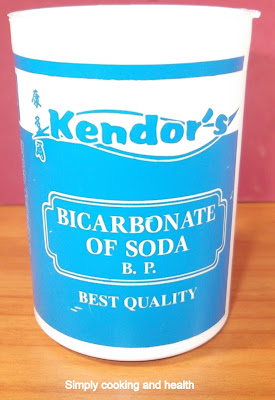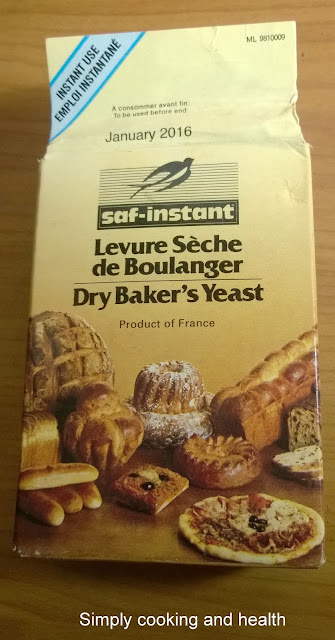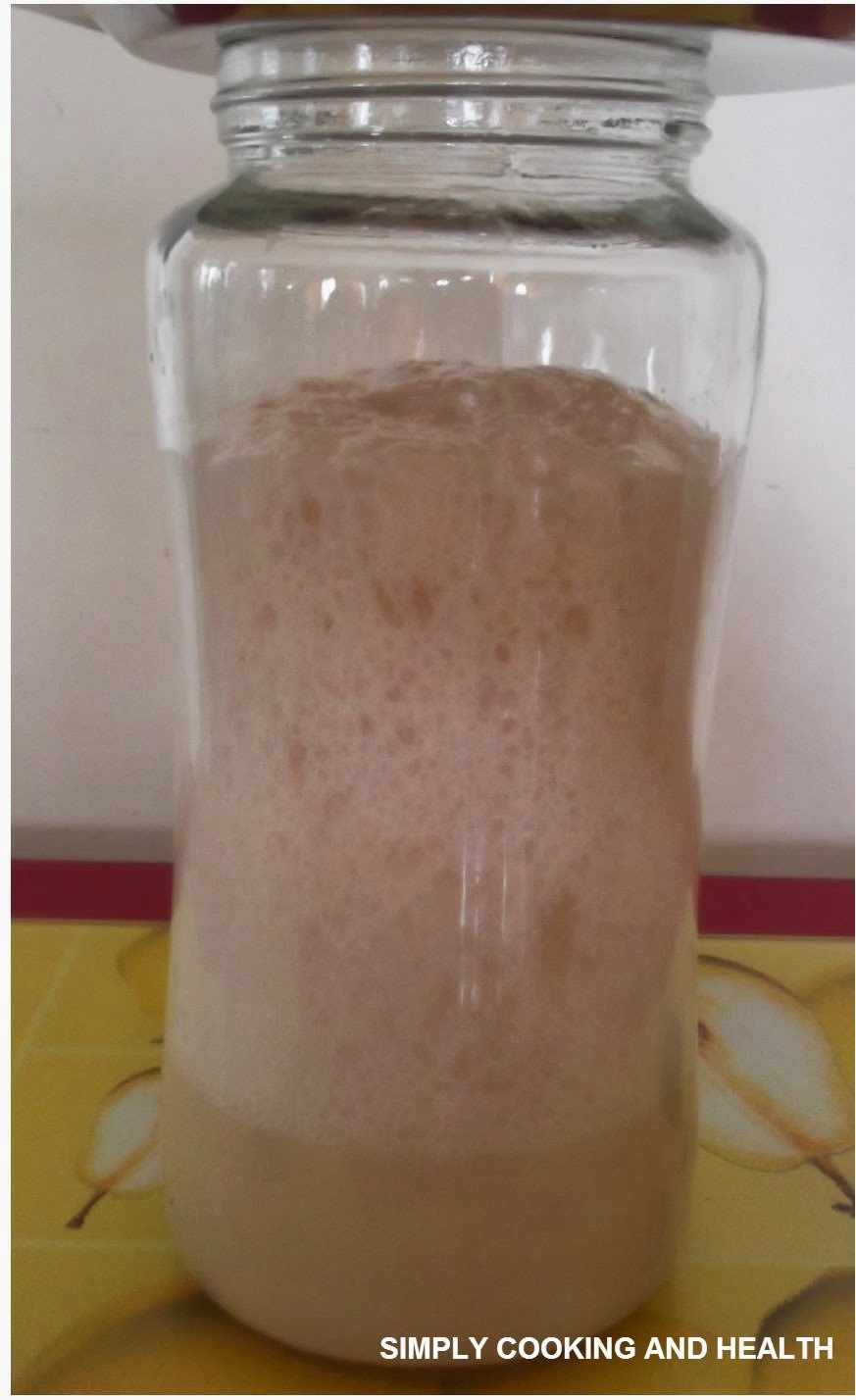 |
| Baking soda |
Baking powder and baking soda are both leavening agents to produce carbon dioxide and to cause the flour to which it is added to “rise”.
Baking soda
Baking soda is just sodium bicarbonate. When baking soda mixes with moisture and an acidic ingredient (such as lemon juice, vinegar, chocolate, yogurt or honey) the resulting chemical reaction produces bubbles of carbon dioxide that expand under oven temperatures, causing baked goods to rise. As the reaction begins immediately upon mixing the ingredients, you need to bake recipes which call for baking soda immediately, or else they will fail.
Baking soda is slightly bitter in taste and is countered by adding some acidic ingredient.
Baking soda has many uses.
1. Use it as a tooth paste and freshen your mouth.
2. Soak your oral appliances.
3. Three parts of baking soda to one part of water makes an excellent facial and body scrub.
4. Use it as an antacid to reweave heart burn. It will also alkalize your system.
5. It is used for insect bites and itchy skin.
6. A little baking soda added to your favorite shampoo will remove any residue from styling products.
7. Clean your combs and brushes with baking soda.
8. It makes a good bathing soak and it soothes your feet.
9. Clean your pots and pans, microwave oven, silverware, oven, tea pots, refrigerator and practically everything else in your kitchen.
10. Add a little baking soda to your laundry detergent to get cleaner wash. The pH balance also helps in removing stains from your clothes.
11. You can use it to deodorize anything that can be washed.
12. You can use it to scrub fruits and vegetables.
13. If you have a cramp mix one teaspoon of baking soda with some water and drink it. The cramp will go away within a minute.
 |
| Baking powder |
Baking powder
Baking powder contains sodium bicarbonate (baking soda), crème of tarter an acidifying agent and starch ( a drying agent). In the case of baking soda we noticed that we needed to add an acidifying agent. Baking powder already contains that.
Baking powder is available in two forms – single-action and double-action. Single-action baking powder is activated by just adding moisture and you must start baking as soon as possible after adding the moister. Double-action baking powders work in two phases. The first phase starts immediately upon mixing with moisture. The second phase starts after standing for some time. In the case of double-action baking powder some gas is released at room temperature. But in the case of both the single-action and double-action powders, the bulk of the gas is released after the temperature of the dough increases in the oven.
You can make your own baking powder by mixing 2 parts of cream of tartar and one part of baking soda. You must use this immediately. You cannot make a batch and keep it. When you make your own baking powder it will be fresher than a sore-bought product.
You cannot always replace baking soda with baking powder. If a recipe calls for a teaspoon of baking soda and if you add one teaspoon of baking powder, it will contain only one-third teaspoon of baking soda. If your recipe already includes an acidifying ingredient then it is useless to add baking powder. If your recipe includes some acidic ingredients then you will need to add enough baking soda to neutralize the acidity. In such cased you will need to add a little baking powder to give the extra lift to make your recipe taste great.
Cream of tartar
Cream of tartar (Potassium bitartrate) is a powdered form of tartaric acid. Tartaric acid forms at the bottom of the wine making barrels.
Uses of Cream of tartar
(1) It stabilizes the eggs while whipping them for meringue;
(2) It can be used as a leavening agent along with baking soda;
(3) it is used to make frosting and creamy icing;
(4) It reduces discoloration of boiled vegetables;
(5) It can be used as a thickening agent;
(6) When it is mixed with an acidic liquid such as lemon juice or white vinegar it becomes a good cleaning agent for aluminum, copper and brass.
(7) When it is mixed with hydrogen peroxide, it cleans rust from hand tools.
(8) A paste made of cream of tartar and vinegar repelling ants and other small insects around the house.
Cream of tartar prevents sugar from crystallizing.
Yeast
Yeast is kind of fungi. It has been in brewing and fermentation for over 4000 years. During fermentation, yeast converts carbohydrates into carbon dioxide and alcohols. For thousands of years yeast has been used in making alcohol and in baking. Other species of yeasts, such as Candida cause infections in humans.
Yeast cells grow well in rich carbon sources such as glucose. They also grow in fermentation where glucose is converted into carbon dioxide and ethanol. Fermentation occurs in anaerobic condition where oxygen is absent. Yeast used in the production of beer and wine is known as brewer’s yeast.
Baker's yeast is used as a leavening agent in baking. The carbon dioxide produced during fermentation causes the flour to rise (expand). While baking the yeast will die and carbon dioxide will escape leaving air pockets which give the bread a spongy texture.
 |
| Dry Yeast |
Granulated active dry yeast does not require refrigeration. It has a longer shelf life than fresh yeast, and it rises twice as fast.
Fresh baker’s yeast is also available in the market. It perishes quickly and must be used immediately after production. You can tell whether the yeast is active or dead by adding a little yeast to a weak solution of sugar. If the yeast bubbles it is active otherwise it is dead. This test is called “proofing” the yeast. From this the word “proofing” is used to mean staring the fermentation process.
Beer is mainly produced by brewing with the help of yeast. Non alcoholic carbonated drink such as root beer is made by the same process but the fermentation is stopped sooner before the formation of alcohol. Kvass is a popular beverage in Eastern Europe. It has a very low alcoholic content. Kombucha is a sweet fermented tea using yeast in conjunction with acetic acid bacteria.
Some people take nutritional yeast as a supplement. Nutritional yeast has a cheesy nutty flavor. It is sometimes used as a cheese substitute. It is very popular among vegans. It is also used as a taste enhancer.
When baker’s yeast is added to the flour with water the carbon dioxide begins to form. At this point it is necessary to knead the dough. This aerates the dough and develops gluten (elasticity) in the flour. When you knead, air pockets are developed in the dough. The air pockets become smaller and smaller and are well distributed with further kneading. The final texture of the bread will depend on how well you knead the dough. In commercial bread production kneading is done by machines. Machine kneaded products tend to have finer texture than those kneaded by hand.
When the dough has a smooth and satiny appearance it signifies that is as adequately kneaded. Now the dough covered with a plastic wrap and left to rise in a dry and warm place to rise. The dough will double in size. When it has doubled in size it is “punched down” to release larger pockets of air and to deflate. At this point there may be a second rising depending on the recipe. If a second rising is not needed, the dough is shaped and placed in a pan to rise for a very short period of time. The dough is now ready for baking.
 |
| Yeast after proofing. You can see some bubbles on top. |
No comments:
Post a Comment